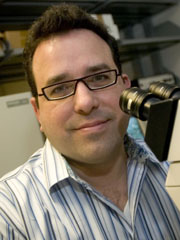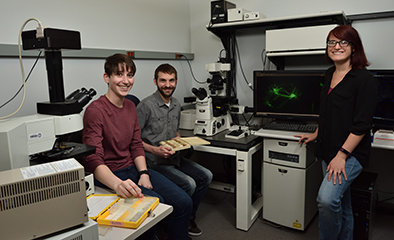CBMP Faculty
Gerard L. Apodaca, Ph.D.

Department: Medicine, Renal-Electrolyte
Email: gla6@pitt.edu
PubMed: Link
Dept / Lab Webpage: http://apodaca2.dept-med.pitt.edu/
CBMP groups: Membrane Traffic of Proteins and Lipids
Research Interests
Epithelial Cell Overview:
Epithelial cells form glands and cover both the inner and outer surfaces of organ systems such as the urogenital tract, gut, and cardiovascular system. They can selectively modulate the passage of water, ions, solutes, and large molecules and they prevent pathogen entry across the tight barrier formed by adjacent cells. Epithelial cells characteristically have two plasma membrane domains, apical and basolateral, which are demarcated by apico-lateral junctional complexes. In the epithelial cells that line the nephrons of the kidney or the surface of the bladder, there is constant flux of proteins and lipids to and from both plasma membrane domains. This traffic is crucial during the establishment and maintenance of these surface domains as well as to the barrier, sensory, and ion/solute transporting properties of these cells. In biosynthetic transport, newly synthesized secretory and membrane cargoes are vectorially delivered from the endoplasmic reticulum to the Golgi apparatus, to the trans-Golgi network, and then to either the apical or basolateral membrane domain. In some cases, newly synthesized cargo is transported through endocytic intermediates prior to delivery to the cell surface. In endocytic transport, membrane proteins as well as solutes are internalized from either the apical or basolateral plasma membrane domains. Internalization can occur via clathrin-dependent or -independent pathways. Subsequently, endocytosed cargo is delivered to distinct apical or basolateral early endosomes, from which they are recycled, delivered to lysosomes for degradation, or transported to the opposite pole of the cell in a process termed transcytosis.
Membrane Traffic in Umbrella Cells:
The uroepithelium, which lines the renal pelvis, ureters, and bladder is comprised of several cell layers including the outermost umbrella cells that interface with the urine. These cells form a tight barrier that prevents toxic wastes present in urine from entering the underlying blood supply. Components of this barrier include tight junctions and the special apical membrane lipid and protein composition. An important aspect of the barrier is that it must accommodate large changes in volume as the bladder fills and empties. At the cellular level it is hypothesized that this is accomplished by the reversible insertion and retrieval of small discoidal/fusiform vesicles (DFVs) that underlie the apical surface of the umbrella cells. We are interested in defining how the umbrella cells sense changes in membrane stretch and then how these changes are translated through second messenger cascades into vesicle fusion events, and then membrane recovery through endocytosis. Some of our current research projects include: defining the mechanosensors and signal transduction cascades that respond to changes in stretch and other mediators in the umbrella cell environment; exploring the regulatory Rab GTPases and their effectors and determining how downstream signaling cascades modulate DFV exocytosis; revealing how membrane stretch is coupled to integrin signaling and stimulation of the endocytic machinery; exploring the fate of endocytosed membrane and fluid in umbrella cells; and investigating how uropathogenic Escherichia coli alter membrane trafficking events in these cells.
Sensory Function of the Uroepithelium:
In addition to barrier function, the uroepithelium may also function as part of a "sensory web" that includes the uroepithelium, the urine space, and the underlying capillary bed, closely apposed nerve fibers including sensory afferents, interstitial cells, mast cells, small rests of smooth muscle cells, and finally the detrusor/sphincter muscles. The epithelium expresses both a large number of receptors and channels that can receive sensory "input" from the urine (e.g. growth factors or stretch during bladder filling) and underlying tissues, as well it can release a myriad of mediators (sensory ouputs) including ATP, adenosine, NO, and acetylcholine. We hypothesize that this sensory web is required for the coordinated function of the bladder during the cycles of filling and voiding, and disruption of any of the target tissues or their communication is likely to lead to bladder dysfunction. Our current studies include: defining the receptor and channel diversity on the surfaces of the cells that comprise the uroepithelium; exploring how one mediator, adenosine, is produced and degraded by the uroepithelium; using stimulation of adenosine receptors as a model system to understand how bladder function can be altered by extracellular adenosine; defining the trans-epithelial pathways that couple adenosine receptor stimulation to changes in bladder function.
Membrane Traffic in Kidney Cells:
In MDCK and cortical collecting duct cells we are studying the endocytic system of kidney epithelial cells, especially those pathways involved in transcytosis and apical membrane recycling. We are working on defining the endosomal compartment involved in this traffic and the regulatory mechanisms that control membrane flow into and out of these organelles. Our current research efforts include: studying the role of the exocyst, an eight subunit adaptor/tethering complex, in apically directed endocytic traffic; examining the role of regulatory molecules such as EHD1 in endocytic recycling; and exploring how Rab proteins regulate endocytic traffic in kidney cells.
